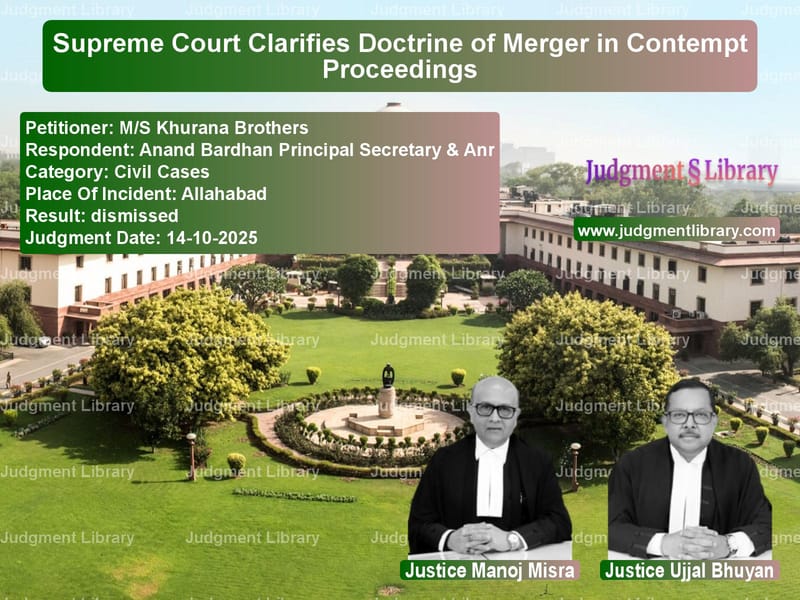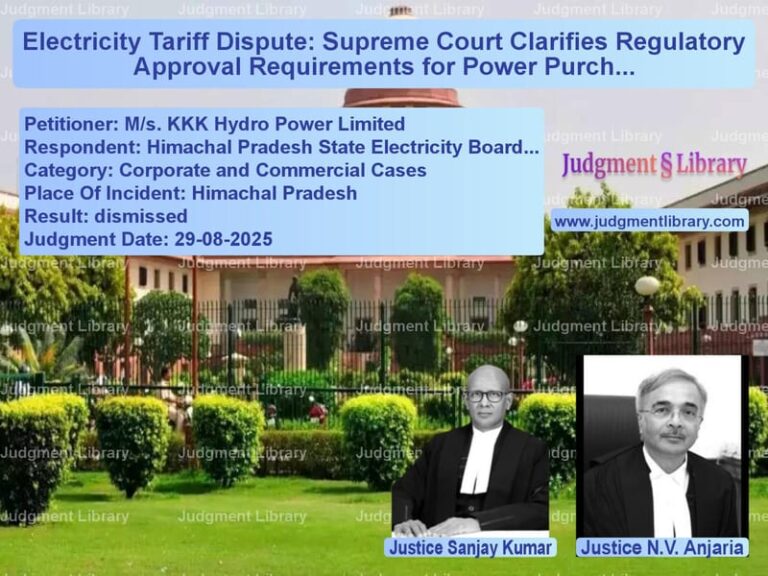Supreme Court Clarifies Doctrine of Merger in Contempt Proceedings
In a significant ruling that clarifies the application of the doctrine of merger in contempt proceedings, the Supreme Court of India recently disposed of a contempt petition while providing important insights into when the doctrine applies and when it doesn’t. The case involved M/s Khurana Brothers, who had filed a contempt petition alleging willful disobedience of the Supreme Court’s order dated January 4, 2023. However, the Court, in its wisdom, determined that the contempt petition should properly be pursued before the High Court rather than the Supreme Court, thereby providing valuable guidance on the jurisdictional aspects of contempt proceedings and the nuanced application of the doctrine of merger.
The Background of the Case
The legal journey began with Civil Appeal No. 76 of 2023, which was filed against an order of a Division Bench of the High Court of Judicature at Allahabad. This Division Bench order was passed in an intra-court appeal against an order of a Single Judge of the High Court. Interestingly, while the intra-court appeal was dismissed by the Division Bench, certain observations were made that, according to the petitioner, made their position worse than what it was after the order of the Single Judge. This perceived deterioration in their legal position prompted the petitioner to approach the Supreme Court by seeking leave to appeal.
When the matter came before the Supreme Court, the learned counsel for the appellant took an unusual approach. Instead of pressing the appeal on its merits, he made a statement that he may be permitted to withdraw the intra-court appeal that was filed before the Division Bench of the High Court. The purpose behind this request was to restore his position as it existed under the order of the Single Judge of the High Court. This strategic move was accepted by the Supreme Court through its order dated January 4, 2023. The appeal was disposed of with the observation that the intra-court appeal preferred before the Division Bench of the High Court shall stand withdrawn, and the parties shall work out their respective rights in terms of the order of the learned Single Judge of the High Court.
The Contempt Petition
Following the Supreme Court’s order, the petitioner filed the present contempt petition alleging that the contemnor respondents had not complied with the order of the Single Judge of the High Court as restored by the Supreme Court’s order dated January 4, 2023. This raised an important legal question about jurisdiction: where should the contempt petition be filed when the original order being enforced is that of a High Court Single Judge, but the restoration of that order came through a Supreme Court proceeding?
When the matter was initially taken up, the Court had passed an order requesting the counsel for the petitioner to address the Court as to why this contempt petition should not be disposed of by giving liberty to the petitioner to initiate such proceedings, if required, before the High Court. The Court’s reasoning was that since the order of which violation was alleged was essentially that of the Single Judge of the High Court, consequent to the withdrawal of the intra-court appeal, the proper forum for contempt might be the High Court itself.
The Petitioner’s Argument
In response to the Court’s query, the learned counsel for the petitioner made a significant legal argument. He submitted that “as the order of this Court dated 4.1.2023 was passed after grant of leave, the doctrine of merger would apply and, therefore, the contempt would lie before this Court.” This argument was based on the understanding that when the Supreme Court passes an order after granting leave to appeal, the doctrine of merger comes into play, meaning that the High Court’s order merges with the Supreme Court’s order, and thus any contempt of that merged order would fall within the Supreme Court’s jurisdiction.
The Court’s Analysis and Reasoning
The Supreme Court, comprising Justices Manoj Misra and Ujjal Bhuyan, carefully considered the petitioner’s argument but found it unconvincing in the facts of the present case. The Court delivered a nuanced interpretation of the doctrine of merger, stating: “The aforesaid submission may appear attractive but in the facts of the present case is not acceptable. Reason being the doctrine of merger is not a doctrine of rigid and universal application and it cannot be said that wherever there are two orders, one by inferior court or tribunal and the other by superior court or tribunal, passed in an appeal or revision, there is fusion or merger of two orders irrespective of the subject matter of the appellate or revisional order and the scope of appeal or revision contemplated by the particular statute.”
The Court relied on the precedent set in State of Madras v. Madurai Mills co. Ltd. (1966), where a three-Judge Bench of the Supreme Court had held that “application of the doctrine of merger depends on the nature of the appellate or revisional order in each case and the scope of the statutory provisions conferring the appellate or revisional jurisdiction.” This established that the doctrine of merger is not automatically applicable in all cases where a superior court passes an order; rather, its application depends on the specific circumstances and the nature of the appellate proceedings.
Applying this principle to the present case, the Court observed: “In the case on hand, this Court had allowed the petitioner to withdraw the intra court appeal in which the order under challenge in appeal before this Court was passed. As a result, once the appeal before the Division Bench of the High Court stood withdrawn so did all orders passed therein. Once that is the position, by fiction of law the parties would stand relegated to the stage at which they were on the date of filing of the intra court appeal. In such circumstances, the order of the learned Single Judge of the High Court would operate from the date of this Court’s order as if it had never been challenged.”
The Court’s Final Decision
Based on this reasoning, the Court concluded: “In our view, therefore, contempt, if any, would lie before the High Court. We, accordingly, deem it appropriate to dispose of this contempt petition by giving liberty to the petitioner to initiate contempt proceedings before the High Court if the order of the Single Judge of the High Court has been violated, as is alleged.”
The Court made it clear that it was not expressing any opinion on the merits of the matter, thereby leaving it open for the petitioner to approach the High Court for appropriate relief. The contempt petition and all pending applications were disposed of accordingly.
Significance of the Judgment
This judgment is significant for several reasons. First, it clarifies that the doctrine of merger is not a rigid or universally applicable principle but depends on the specific circumstances of each case. Second, it establishes that when the Supreme Court merely allows the withdrawal of an appeal without substantially adjudicating on the merits, the doctrine of merger does not automatically apply. Third, it provides guidance on the jurisdictional aspects of contempt proceedings, emphasizing that the forum for contempt is determined by the origin of the order being enforced rather than the court that may have incidentally referenced or restored it.
The ruling also highlights the Supreme Court’s role as a constitutional court that carefully considers jurisdictional boundaries between different courts in the Indian judicial hierarchy. By directing the petitioner to approach the High Court for contempt proceedings, the Supreme Court reinforced the principle that each court should exercise jurisdiction over matters that properly fall within its domain, thereby promoting judicial efficiency and proper allocation of judicial resources.
For litigants and legal practitioners, this judgment serves as an important reminder that strategic decisions in litigation, such as withdrawing appeals, can have significant implications for subsequent proceedings, including contempt applications. It emphasizes the need to carefully consider the jurisdictional consequences of such procedural moves.
In conclusion, the Supreme Court’s decision in this case provides valuable clarity on the application of the doctrine of merger in contempt proceedings and reinforces the importance of proper jurisdictional boundaries in the Indian judicial system. While disposing of the contempt petition, the Court has ensured that the petitioner’s rights are protected by granting liberty to approach the appropriate forum—the High Court—for seeking redressal for the alleged violation of the Single Judge’s order.
Petitioner Name: M/S Khurana Brothers.Respondent Name: Anand Bardhan Principal Secretary & Anr.Judgment By: Justice Manoj Misra, Justice Ujjal Bhuyan.Place Of Incident: Allahabad.Judgment Date: 14-10-2025.Result: dismissed.
Don’t miss out on the full details! Download the complete judgment in PDF format below and gain valuable insights instantly!
Download Judgment: ms-khurana-brothers-vs-anand-bardhan-princi-supreme-court-of-india-judgment-dated-14-10-2025.pdf
Directly Download Judgment: Directly download this Judgment
See all petitions in Contempt Of Court cases
See all petitions in Legal Malpractice
See all petitions in Other Cases
See all petitions in Judgment by Manoj Misra
See all petitions in Judgment by Ujjal Bhuyan
See all petitions in dismissed
See all petitions in supreme court of India judgments October 2025
See all petitions in 2025 judgments
See all posts in Civil Cases Category
See all allowed petitions in Civil Cases Category
See all Dismissed petitions in Civil Cases Category
See all partially allowed petitions in Civil Cases Category







